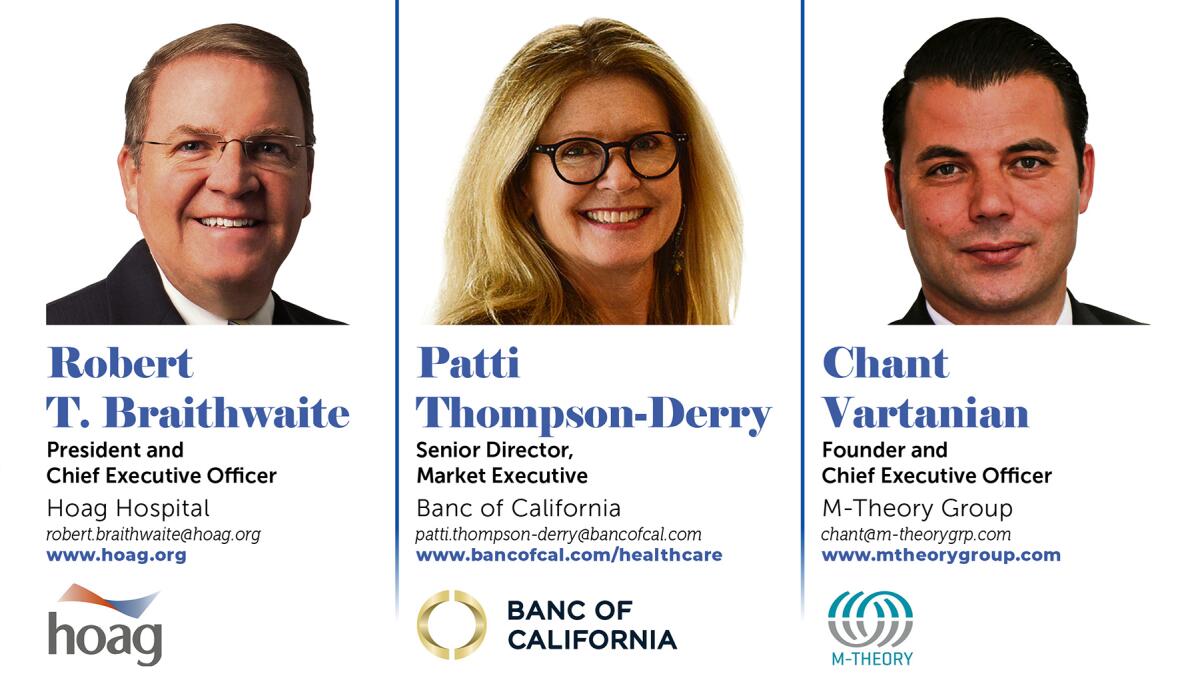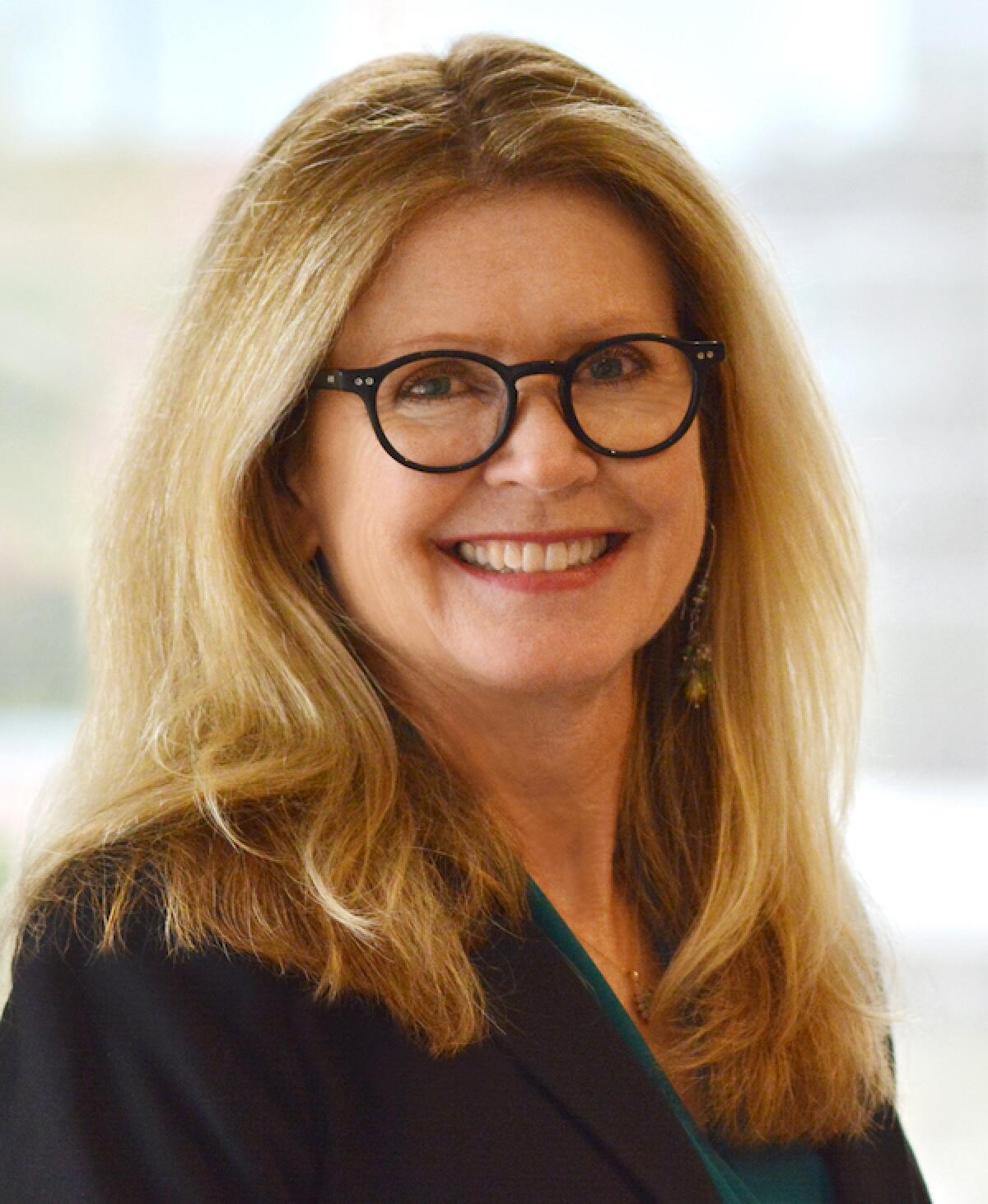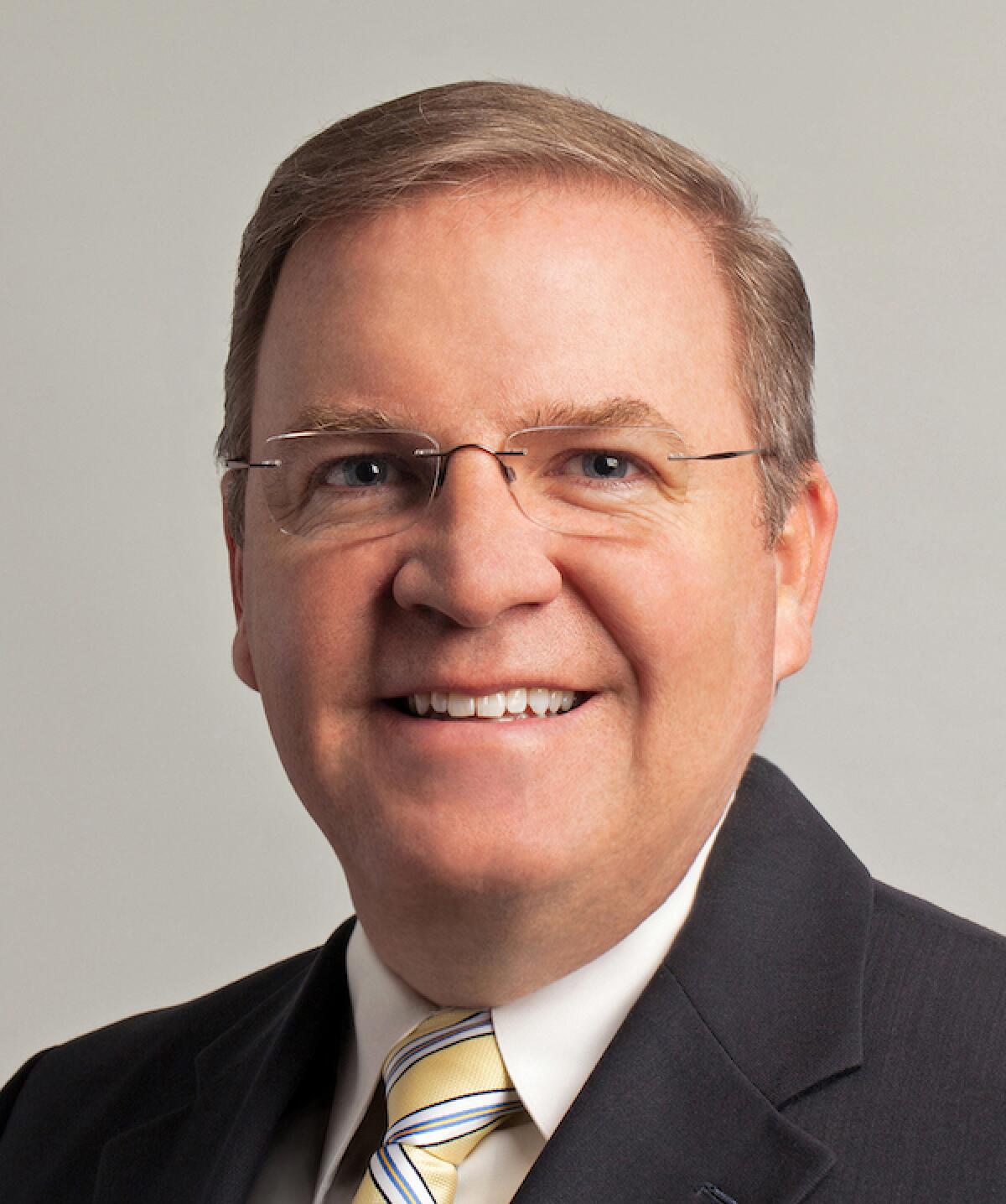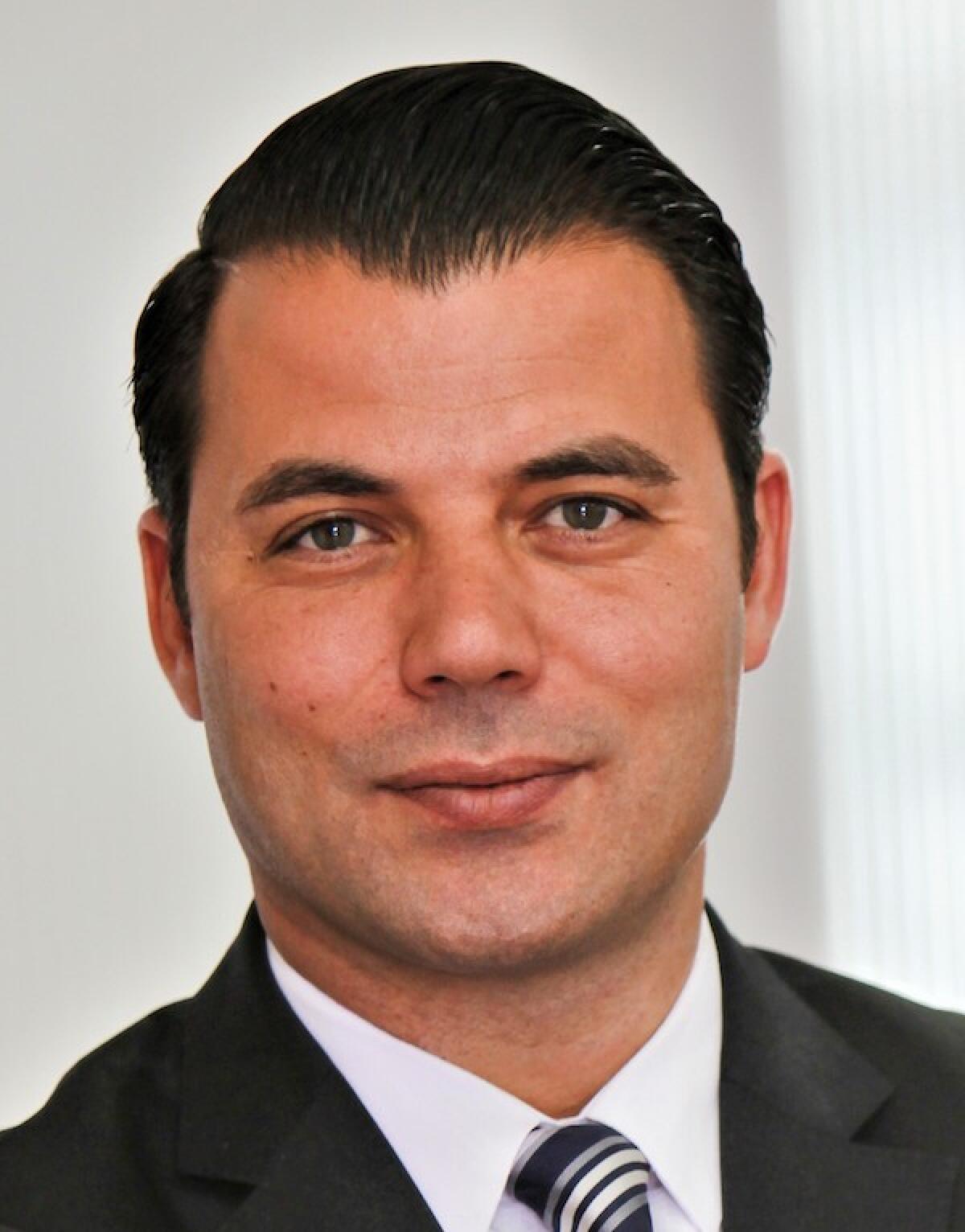Health Care Industry Roundtable

The Health Care Industry panel is produced by the L.A. Times Brand B2B Publishing team in conjunction with Banc of California; Hoag Hospital; and M-Theory Group.
Treatment modalities and care best practices aside, the healthcare business sector – perhaps more than any other category of industry – has been forced to reassess, restructure and remodel itself to accommodate the unpredictable and challenging times we have faced over the last year and a half due to the COVID-19 crisis.
As the number of reported COVID infections decreases and business starts to edge toward a semblance of normalcy in Southern California, decision makers in the healthcare space are left with a number of challenging questions. Are the changes in operational protocols, regulatory issues, insurance considerations, and financial issues here to stay? Or were the shifts we’ve seen merely temporary?
To take a closer look at the latest concerns and trends in the business of healthcare, we have turned to some of the region’s leading experts, who graciously weighed in for a discussion and shared insights on the state of healthcare in 2021.
Q: Obviously, the frontlines of the healthcare sector have been forced to make changes over the last year due to the COVID-19 pandemic. How dramatically have the healthcare business and operational landscapes changed in the last year?

Patti Thompson-Derry, Senior Director, Market Executive, Banc of California: Significant changes arrived on two fronts. First, many senior healthcare professionals chose to retire and close or sell their practices. Second, doctors and dentists further from retirement reported robust rebounds, some to the point of having a record year, with most reporting routine checkup backlogs of over 90 days. We attribute that to pent-up demand and the retirement or slowing of aging professionals and their patients seeking alternate providers. Banc of California can assist rising healthcare professionals find the right practice in the right locations, because we are market aware and have contacts in the practice brokerage, real estate, equipment, consulting, legal, and accounting spaces. Our deep healthcare-specific expertise enables us to help them negotiate better practice and real estate purchases, because the majority of the dental broker community typically represents the seller’s interests.

Robert T. Braithwaite, President and Chief Executive Officer, Hoag Hospital: Across the nation, there is a significant ongoing shift in how and where people access medical care. Locally, in response to a reduction in hospital-based care and lower emergency department visits, Hoag is bringing world-class healthcare to individuals and families right where they live and work – via new and expanded telehealth and outpatient offerings at health centers and urgent care facilities. Providing world-class care right here in Orange County remains our No. 1 priority, as reflected by being the highest-ranked hospital in Orange County by U.S. News & World Report. But providing it in a way that accommodates people’s daily lives and needs is also paramount.
Q: How well have the health provider organizations and businesses (hospitals, private practices, insurance, etc.) in Southern California responded to the situation?

Chant Vartanian, Founder and Chief Executive Officer, M-Theory Group: In times of crisis, it’s always astonishing to see how strongly humankind responds. We’ve watched the world rebuild itself on a scale we’ve never had to. Here in SoCal, we’re used to putting out literal fires. Only a year ago we were waiting to be vaccinated, to reopen shops, to visit beaches, restaurants, and homes. Now, we’re back to rebuilding the time we’ve had to put on pause. After declaring a state of emergency, front-line workers never failed to show. Policymakers of healthcare and business insurance have adapted and continue to adapt to the current interruption of normal business, for example, as seen with the COVID-19 business interruption protection gap.
Braithwaite: One thing the pandemic taught us is that healthcare can move quickly. As the world’s understanding of COVID-19 changed rapidly, the community looked to leading health organizations such as Hoag for guidance, information, critical updates and reassurance as the situation evolved. At Hoag, we were able to expedite solutions to some of the barriers healthcare delivery can typically face – such as accelerated COVID-19 clinical trials and implementing new technology, protocols and procedures to care for and protect our patients, physicians, clinical care providers and employees.
“The quick and willing migration to virtual operations in every field, for every industry, was overwhelmingly positive. In every way, the world became smaller and larger over this past year.”
— –Chant Vartanian
Thompson-Derry: We have seen multiple examples of healthcare professionals pivoting to telehealth models to provide needed services to patients. A dermatology group implemented their telehealth platform prepandemic and were not only able to assist their own skyrocketing patient demands, but they also assisted their friendly competitors by allowing them access to their platform while all offices were shut down for two months. Another dental practice was able to preplan their patient visits via online meeting software, resulting in shorter wait times and fewer face-to-face interactions, which was a relief to providers and patients alike. As a healthcare banking partner, we were in a position to assist practices like this to meet the demand and grow by providing working capital for expansion of capability, as well as leveraging a company’s real estate assets into a vehicle for expansion by cash-out refinance of their commercial real estate.
Q: What emerging trends will impact the healthcare industry in the near future?
Vartanian: We believe technology platforms that have been absent from many small- to medium-sized healthcare providers will begin to take root. Specifically, cybersecurity tools and services will become more broadly adopted in response to a growing awareness of this long-underserved need. With alarming frequency, mainstream news covers yet another hacked healthcare provider. Thinking has changed slowly – from adopting a security-first mindset only after being a victim to embracing a more proactive approach and focus on prevention. This means taking a hard look at all facets of Information Technology in the context of achieving a healthy security posture and protecting healthcare operations.
Thompson-Derry: The obvious example is the Emergency Use Authorization of the Messenger RNA technology used to fast-track the COVID-19 vaccine, which may show a way for expedited approvals in the future. Banc of California is exploring solutions to assist innovative healthcare and pharmaceutical companies on the rise with substantial venture and established collaboration backing by providing real estate-based financing to help them build capacity and meet future demand.
Q: What business opportunities have presented themselves during COVID-19 in the world of healthcare?
Braithwaite: The pandemic has opened doors for some exciting partnerships within our community. Most recently, Hoag opened the Fly Well Clinic at John Wayne Airport, which offers travelers from Orange County and around the world access to quality health services including COVID-19 vaccinations, urgent care services, telehealth consultations, vital screenings, treatment of minor illnesses and injuries and prescriptions. This local, first-of-its-kind health clinic provides convenient access to Hoag’s world-class specialty and diagnostic services. From temperature screenings at Disneyland to vaccine clinics at local senior centers and retail shopping centers, Hoag has also partnered with city leaders and businesses throughout Orange County to help guide and implement clinical solutions to keep people safe and healthy, while mitigating the risk of COVID-19.
Thompson-Derry: Since online sales have supplanted many businesses that relied on foot traffic, many healthcare professionals have set themselves up in former retail settings. We see urgent care offices in former clothing store spaces, as well as groups of healthcare professionals who purchased and repurposed entire general office buildings into medical-specific use. At Banc of California, we have a robust platform providing owner-occupied financing and investor financing for medical buildings to healthcare professionals and practices looking to take advantage of these opportunities in the Southern California markets.
Q: Now that we know what we know, what can the healthcare sector do to better prepare for a potential future crisis?
Braithwaite: Hoag has served the community for nearly 70 years; in that time, we’ve never failed to rise to the challenge during difficult circumstances and provide exceptional healthcare for those we serve. I’m very proud to think about how our entire family of physicians, nurses and staff really dug in during the pandemic and figured out how to set up a safe and effective triage and treatment system right out of the gates. And frankly, I am in awe of the fact that our clinical quality indicators actually improved over the past year, which is a testament to the collaborative nature of the medical staff with our hospital leadership and staff. To accomplish quality improvements during a pandemic is humbling and something that makes our entire team very proud. I also think it’s important that in future crisis situations, more collaboration across the public health spectrum would be helpful to not only us but statewide.
“Pre-pandemic, a majority of telehealth platform users were reluctant to use it, but, as with many businesses, the use of online meeting software proved vital and substantially improved efficiency.”
— –Patti Thompson-Derry
Q: As independent medical and dental practices continue to recover from the pandemic and look for ways to meet the pent-up demand, would now be a good time to invest in payroll, supplies and new technology?
Thompson-Derry: These are challenging times for independent medical and dental practices as consumers have put off routine checkups and elective procedures during the pandemic. Having access to banking solutions and financing geared to healthcare professionals is critical, as practices become fully operational and begin looking for ways to grow in the current economic environment. With government assistance programs coming to an end, these practices will have to find other methods to sustain and support growth. At Banc of California, we recently launched a product called Banc Premier, which was created specifically to meet the needs of smaller businesses by providing fast funding to secure short-term working capital to invest in new technology, increase inventory or put towards payroll. Innovative financing paired with robust treasury management services can help these practices meet pent-up demand.
Q: Do you see any silver lining to come from the pandemic scenario?
Vartanian: We figured out effective work-from-home strategies! This was true even for organizations that did not have existing remote worker policies or even believe it was possible. While this allowed productivity away from the traditional office, it highlighted the need to have matching policies and technology to ensure higher levels of security awareness. Fortunately, the work-from-home movement has directly affected this complementary need for better cybersecurity and a healthy security posture.
Braithwaite: The pandemic forcefully underscored the critical importance of research and clinical trials that contribute to the development of new and effective treatments for existing and emerging diseases. Even before successfully treating California’s first known COVID-19 patient back in January 2020, Hoag was conducting more than 150 clinical trials annually. Early in the pandemic, Hoag quickly became part of the national effort to develop effective treatments for the novel coronavirus. Over the past year, Hoag has conducted more than 20 additional COVID-19 clinical trials to expand patient access to cutting-edge therapies and innovative treatment options. Some of these trials markedly improved outcomes, including decreased mortality and decreased length of stay for hospitalized COVID-19 patients. In October 2020, Hoag became the first in the nation to offer a phase-one trial for a novel COVID-19 vaccine candidate being developed here in Southern California. Our community deserves world-class care right here in Orange County - that is our aim and our standard.
Q: How will virtual care and/or telemedicine affect the healthcare landscape moving forward?
Thompson-Derry: Pre-pandemic, a majority of telehealth platform users were reluctant to use it, but, as with many businesses, the use of online meeting software proved vital and substantially improved efficiency. Less commuting time meant more time getting vital tasks done, and while many providers are excited to return to face-to-face interactions, the pandemic sped up the adoption of technologies and processes that will become standard practice in the near future. Some enterprising dental practices in Southern California employed full-time treatment planners to interview patients in advance of their visit. The result was reduced patient waiting times and improved patient throughput, and it provided employment to dentists at home. We believe these processes and technology will become permanent parts of a thriving practice, and a strong healthcare-focused banking partner can provide healthcare companies with lines of credit secured by the assets of the practice or available commercial real estate to support innovation.
“One thing the pandemic taught us is that health care can move quickly. As the world’s understanding of COVID-19 changed rapidly, the community looked to leading health organizations such as Hoag for guidance.”
— –Robert T. Braithwaite
Vartanian: The quick and willing migration to virtual operations in every field, for every industry, was overwhelmingly positive. In every way, the world became smaller and larger over this past year. In regard to the healthcare industry, virtual care and telemedicine have been made more accessible, more fruitful, and more convenient. Moving forward, I think we will see a lot more openness to mental healthcare, as the stigma of seeking help has been removed through online therapy and virtual communities as the initial step to self-improvement. Once we’re able to revert more fully back to our original lifestyles, I think virtual care will be a useful and desired accessory to healthcare, with the availability of tools similar to Amazon Pharmacy and Better Help.
Q: How are today’s technological advances being leveraged to improve the health and wellbeing of patients?
Braithwaite: To provide world-class care right here in Orange County, you must offer the most advanced technologies and innovations to patients. Doing so, of course, requires a major commitment to academic-based activities - continual learning, investment and advanced training among our medical team and administration. A prime example of this combination of technology and academics is virtual reality, an area in which Hoag has been a national leader since 2015. Our physicians are using virtual reality (VR) tech to assist surgeons with operations, as well as treat patients for pain management and support them with education and mindfulness tools. Recently, Hoag co-developed NurtureVR, a first-of-its-kind program for expectant mothers that uses VR to augment prenatal education, pain management related to pregnancy, mindfulness and support women through postpartum care. We also invested in the mental health of our own healthcare workers by piloting a new program called CenteredVR, a virtual reality-based mindfulness and stress management program to help frontline healthcare workers reduce chronic stress, build resilience and enhance coping skills.
Vartanian: There are so many new technological advancements, but all can be sidelined without matching improvements in cybersecurity. We believe this is paramount to safeguarding patient data and healthcare operations. In turn, this ensures healthcare operations remain open and available to patients. We have all seen stories about hospitals and clinics that went offline while sorting out a security compromise through ransomware. We cannot serve our patients if our facilities are closed due to Information Technology operations problems.
Thompson-Derry: Digital medical record systems have replaced paper files in most practices, cone beam technology assists with advanced procedures like dental implants, and advanced imaging systems produce instant dental images and transmit them to an iPad or computer monitor to be shared with a patient. Patients can be shown the areas of issue and make more informed and immediate decisions about care. Meanwhile, aging Baby Boomer practitioners will not only be retiring, but their aging peers will require increasing dental care. At the same time, fewer dentists are coming out of dental schools to replace them. Those dental professionals who are left will need to rely on these new technologies, along with a bank that understands these trends and can provide equipment financing to help them keep up with increased demand and provide more accurate and effective results for patients.
Q: What advice would you offer a newly launched startup business in the healthcare sector?
Vartanian: If we have a theme to our advice here, it would be to ensure attention is paid to Information Technology and cybersecurity needs from the very beginning. In 2021 alone, we have seen a broad swath of security compromises for healthcare organizations of all sizes. If you do not have a cybersecurity plan, you do not have a complete business plan.
Q: What health-related trends do you think we can expect to come along within the next decade?
Braithwaite: There are only a handful of hospitals like Hoag that combine a personalized, community-based approach with world-class medicine, renowned specialists and access to clinical trials. This “privademic” approach gives our community the best of both worlds - the agility and personalized approach of a private, not-for-profit hospital paired with the world-class innovations of an academic institution. In the next decade, I think this approach will fuel our ability to identify and meet the evolving needs of our community quickly and effectively. We will better be able to draw on our strengths: speed, flexibility, creativity and evidence-based innovation. And when in the best interest of the community, we can partner with other healthcare providers, payors, employers, companies and organizations to continue to bring the best care to Orange County.
Vartanian: COVID-19 has fundamentally reshaped consumer attitudes towards general health and wellness. Workplaces will no longer just provide resources for health and personal care but prioritize ways on improving employee welfare. Individuals will continue to seek self-care and convenience but in deeper, more committed ways. Remote consultations may become the norm, along with remote monitoring through various apps. The people’s appetite for education on health-related matters will only be satiated by multi-pronged, holistic practices. We may see a heightened spike in consumer health companies’ role in delivering brand-agnostic health education and disease management. And now that people have taken this downtime to start exercising, the demand for physical activity through specialized gyms and outdoor activities is sure to increase.